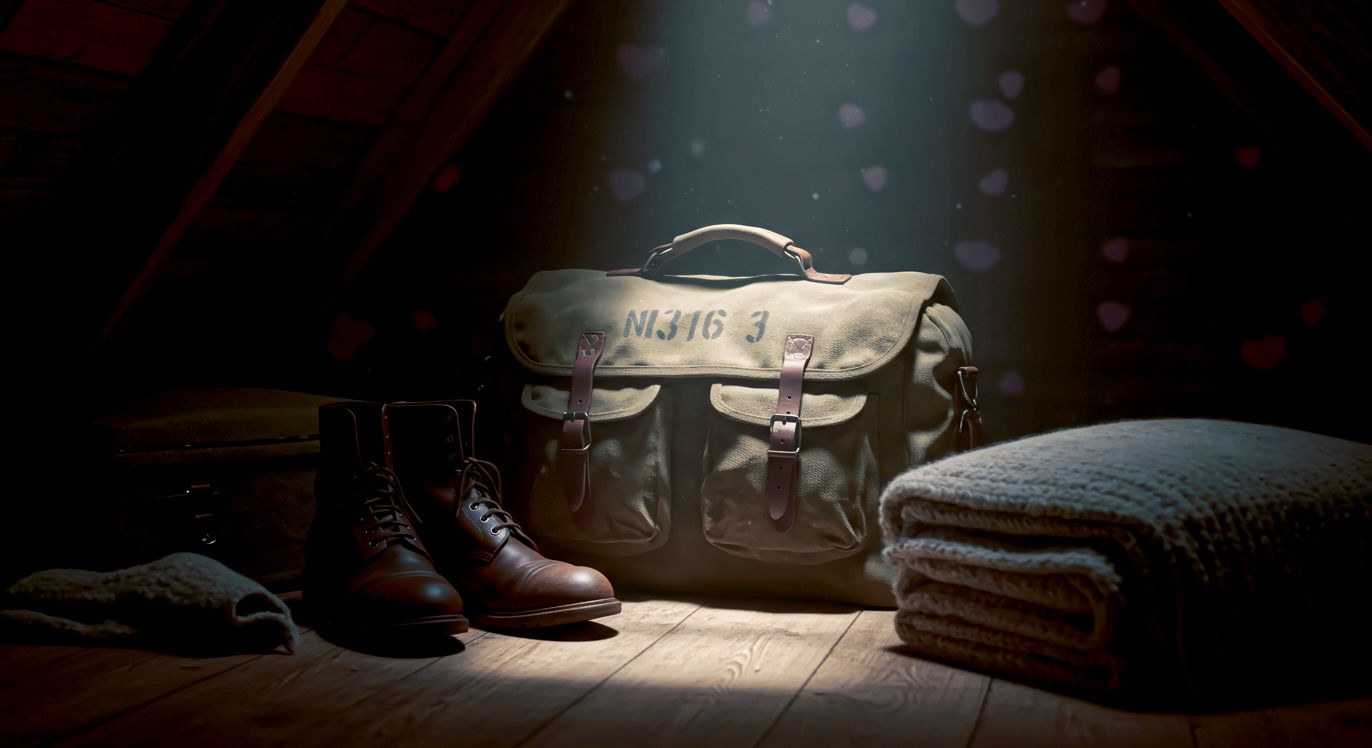The Great British Kit Bag: More Than Just a Bag, It’s a Piece of History
The ultimate guide to the British kit bag. Explore its rich history, cultural significance, and practical uses, from military issue to the modern gym bag.

This post may contain affiliate links. If you make a purchase through these links, we may earn a commission at no additional cost to you.
Picture this. You’re up in the loft, dodging cobwebs and stacks of old magazines. In the corner, under a dusty sheet, sits a long, sausage-shaped canvas bag. It’s faded green, smells faintly of polish and old adventures, and has a name and number stencilled on the side in faded black ink. Maybe it was your grandad’s from his time in the army, or your dad’s from his university rugby days. That, right there, is a kit bag. And it’s so much more than just a bag.
For generations of Brits, the kit bag has been a silent companion on life’s biggest journeys. It’s been hauled onto windswept naval decks, crammed into the back of troop carriers, and slung over the shoulders of Saturday morning footballers. It’s a symbol of service, a vessel for sporting dreams, and a trusty sidekick for anyone heading off on an adventure, whether that’s climbing a mountain or just visiting relatives in Bognor Regis for the weekend.
But what exactly is a kit bag? Where did it come from? And how did this simple, no-nonsense piece of luggage become such a quiet cornerstone of British life? In this ultimate guide, we’re going to unpack the story of the great British kit bag, from its military roots to its place in the modern world. So, grab a brew, get comfy, and let’s dive in.
What Exactly Is a Kit Bag? Let’s Unpack the Basics
Before we get into the nitty-gritty of its history and cultural impact, let’s get one thing straight: what are we actually talking about?
It’s All in the Name
At its heart, a kit bag is a large, durable bag, usually cylindrical in shape, designed to carry a person’s complete set of equipment, or “kit.” The word ‘kit’ itself has been used for centuries to mean a collection of articles needed for a specific purpose. A soldier has his kit, a footballer has her kit, and a plumber has his kit. The bag that carries it all? The kit bag. Simple as that.
It’s the ultimate holdall, designed not for delicate items, but for the essential stuff you need to do a job, play a sport, or live your life away from home. Think clothes, boots, tools, and personal belongings, all bundled together in one robust container.
The Classic Design: Built to Last
The traditional kit bag is a masterclass in simple, functional design. It wasn’t made to be pretty; it was made to be tough. Imagine a straightforward sack that’s built to be chucked about, rained on, and dragged through the mud.
Here are the classic features:
- Tough Material: Originally, they were made from heavy-duty canvas or hessian. This stuff is incredibly strong and can take a real beating. Modern versions might use tough synthetics like Cordura nylon, but the principle is the same: it has to withstand a lot of wear and tear.
- Cylindrical Shape: The long, tube-like shape is very efficient. It allows you to stuff a surprising amount inside and doesn’t have awkward corners that can get snagged or tear.
- Top-Loading: Most classic kit bags load from one end. This opening is usually secured with a simple drawstring and a metal eyelet, sometimes with a flap over the top for extra protection from the rain.
- Simple Straps: You’d typically get a single shoulder strap or a pair of simple carry handles. They weren’t designed for comfort on a long hike, but for the practical purpose of getting the bag from A to B.
It’s a design born from necessity. There are no fancy compartments, no delicate zips, and no unnecessary frills. It’s pure, rugged function.
Kit Bag vs. Duffel Bag: Is There a Difference?
This is a question that trips a lot of people up. You’ll often hear the terms ‘kit bag’ and ‘duffel bag’ used to mean the same thing, and in many ways, they have become interchangeable. But there is a subtle, historical difference that’s quite interesting.
The term ‘duffel bag’ originally came from the town of Duffel in Belgium, which, back in the 17th century, was famous for producing a thick, coarse woollen cloth. This tough fabric, known as ‘duffel’, was used to make the bags. So, a duffel bag was named after the material it was made from.
A ‘kit bag’, as we’ve learned, is named after its purpose – to carry kit.
Over time, the two terms have merged. A cylindrical bag made of tough fabric is now called a duffel bag in America and many other parts of the world. Here in Britain, however, we often still say ‘kit bag’, especially when talking about bags for sports or the military. It’s a small difference, but it hints at the bag’s deep roots in our national story. While any big, soft bag might be a duffel, a kit bag feels more specific—it feels like it’s ready for action.
A Proper British History: The Kit Bag’s Journey Through Time
The kit bag didn’t just appear out of nowhere. It was forged in the heat of conflict and shaped by centuries of British history, from the age of sail to the trenches of the World Wars.
From the High Seas to the Trenches: Military Origins
The story really begins with the Royal Navy. From as early as the 17th century, sailors needed a way to store their belongings in the incredibly cramped conditions of a wooden warship. There was no room for rigid suitcases or trunks. What they needed was something soft and shapeless that could be squashed into any available nook or cranny.
The answer was the ‘sea bag’ or ‘ditty bag’. This was a simple canvas or duffel sack, closed with a drawstring, which held a sailor’s entire worldly possessions: a spare set of clothes, a sewing kit (or ‘ditty’), letters from home, and maybe a treasured keepsake. It was the perfect solution for life at sea and the direct ancestor of the military kit bag we know today.
As the British Army grew and began fighting campaigns across the globe, it adopted this practical piece of luggage. Soldiers, like sailors, needed to carry their kit with them. The kit bag was cheap to produce, easy to carry, and tough enough to survive the rigours of a campaign.
The World Wars: Every Soldier’s Companion
It was during the First and Second World Wars that the kit bag truly became a British icon. For millions of young men leaving home to fight, the standard-issue kit bag was one of their first introductions to military life.
Imagine a young soldier in 1916, standing on a chaotic platform at London’s Victoria Station, about to head for the trenches in France. His entire life is packed into that one, heavy canvas bag slung over his shoulder. Inside would be his greatcoat, his spare uniform, his ‘housewife’ sewing kit, wash-roll, spare boots, and perhaps a few personal items—a photo, a book, or a packet of cigarettes. The kit bag wasn’t just luggage; it was his home on his back.
In official army speak, it was known as the “Bag, canvas, valise” and later the “Kitbag, Universal”. It was a constant presence in the soldier’s life, from the barracks to the battlefield. It was used as a pillow in draughty barns, a seat in muddy trenches, and a barrier against the cold. The simple act of stencilling their name, rank, and serial number on the side transformed a generic piece of equipment into something deeply personal. These bags bore witness to the incredible hardships and quiet moments of a soldier’s life.
Post-War Britain: The Kit Bag Comes Home
When the wars ended and millions of soldiers were demobilised, they brought their kit bags home with them. These bags, often the only piece of luggage they owned, became a common sight in post-war Britain.
They were a perfect fit for the ‘make-do-and-mend’ spirit of the times. Why buy a new suitcase when you had a perfectly good army-issue kit bag? What’s more, army surplus stores popped up in towns and cities across the country, selling off mountains of ex-military equipment for pennies. This made the kit bag cheap, accessible, and incredibly popular.
Suddenly, it wasn’t just for soldiers. Students used them to carry books and laundry to university. Workers used them to carry their overalls and tools. Families packed them for seaside holidays. The kit bag had successfully made the leap from military service to civilian life, becoming a symbol of thriftiness and rugged practicality.
The Kit Bag in British Culture: Icons, Sports, and Adventures
Beyond its practical uses, the kit bag has woven itself into the fabric of British culture. It’s a prop in our national story, appearing in everything from films and books to the weekly rituals of sport and leisure.
Standard Issue: The Modern Armed Forces Kit Bag
The kit bag is still a fundamental piece of equipment for today’s British Armed Forces, although it has had a serious upgrade. The old canvas sack has been replaced by the “Operational Travel Bag”, often referred to as the ‘deployment bag’ or simply the kit bag.
These modern versions are a world away from their historical counterparts. They are often huge—some holding over 100 litres—and are made from high-tech, water-resistant fabrics like Cordura. They feature robust zips instead of drawstrings, multiple compartments for organisation, and often come with wheels and a telescopic handle, making them much easier to move around.
Despite these changes, their core purpose remains the same: to carry everything a service person needs for a long deployment. They are a testament to how the classic design has been adapted for the 21st century, but the link to that simple sailor’s sea bag is still there.
The Saturday Morning Staple: Kit Bags in Sport
For many Brits, the first image that comes to mind when they hear ‘kit bag’ is a sporting one. The bag is as much a part of the weekend sports scene as muddy pitches and the smell of deep heat.
Football and Rugby
Think of any local football or rugby club on a Saturday morning. You’ll see players of all ages arriving with a kit bag slung over their shoulder. It’s a ritual. Inside, you’ll find the essentials for the beautiful (or brutal) game: muddy boots, shin pads, a towel, the team strip, and probably a stray bottle of Lucozade. The kit bag is a badge of honour, a sign that you’re part of a team. It carries the hopes of the match ahead and, later, the dirt and sweat of a game well-played.
Cricket Whites and Gym Kits
It’s the same story in the world of cricket. The long shape of a kit bag is perfect for carrying a cricket bat alongside pads, gloves, and whites. And, of course, millions of us use a smaller version as a gym bag. It’s the go-to choice for carrying trainers, a water bottle, and workout gear. In this context, the kit bag becomes a symbol of a healthy, active lifestyle.
From Everest to the Local Campsite: The Adventurer’s Choice
The kit bag’s rugged, no-nonsense design has always appealed to explorers and adventurers. When you’re heading into the great outdoors, you need luggage that won’t let you down.
Major expeditions to the world’s most remote places, from the Himalayas to the polar regions, have long relied on heavy-duty kit bags. They can be strapped to pack animals, thrown into the back of a Land Rover, or hauled up a rock face without falling apart. Famous British explorers like Sir Ranulph Fiennes would have relied on kit bags to transport their essential equipment through some of the harshest environments on Earth.
This spirit of adventure has trickled down to the rest of us. For anyone heading off on a camping trip in the Lake District or a weekend of hiking in the Scottish Highlands, a kit bag is often the perfect choice. It can hold a sleeping bag, cooking gear, and spare clothes, and it’s soft enough to be squeezed into a car boot already packed with tents and wellies.
Choosing and Using Your Kit Bag: A Practical Guide
Whether you’re joining a new sports team, planning a weekend away, or just need a decent bag for the gym, a kit bag is a brilliant choice. But not all kit bags are created equal. Here’s what you need to know to choose the right one and pack it like a pro.
What to Look For in a Good Kit Bag
Think about what you’ll be using it for. A bag for your weekly five-a-side match has different needs from one that’s going on a two-week trip.
Material Matters
The fabric of the bag is crucial. It determines its weight, durability, and how well it protects your stuff from the elements.
- Classic Canvas: This is the traditional choice. It’s incredibly tough and has a great, timeless look. The downside is that it’s heavy, and it can soak up water if you get caught in a proper British downpour, making it even heavier.
- Ballistic or Cordura Nylon: Most modern, high-quality kit bags are made from this. It’s a synthetic fabric that offers a fantastic balance. It’s much lighter than canvas, highly resistant to tearing and abrasion, and usually has a waterproof coating.
- Polyester: A cheaper alternative to nylon. It’s perfectly fine for a basic gym bag, but it won’t stand up to the same level of abuse as a good quality nylon bag.
- Tarpaulin/PVC: This is a completely waterproof, rubbery material. Bags made from this are often used for watersports or serious expeditions where keeping kit dry is absolutely vital. They are incredibly durable but can be a bit stiff and heavy.
Size and Shape
Kit bag sizes are usually measured in litres, which tells you their volume.
- Small (25-40 litres): Perfect for a gym bag or for a child’s sports kit. It’ll hold trainers, a change of clothes, and a towel with no problem.
- Medium (50-75 litres): The ideal all-rounder. This size is great for a weekend away or for carrying bulkier sports equipment like rugby pads or cricket gear.
- Large (80-120+ litres): These are serious expedition bags. You’d choose this size if you’re going on a long trip and need to carry a lot of gear, like camping equipment or ski wear. Be warned, though: a bag this big can be very heavy and awkward to carry when full!
Straps, Zips, and Handles
How you carry the bag is important.
- Shoulder Strap: The classic option. Look for one that is padded and adjustable for comfort.
- Backpack Straps: Many modern kit bags come with two straps, allowing you to carry them on your back like a rucksack. This is brilliant for heavier loads or if you have to walk any distance.
- Grab Handles: All kit bags should have handles at the top for carrying it by hand. Some also have extra ‘grab handles’ on the ends, which are incredibly useful for hauling the bag out of a car or off a luggage carousel.
- Zips vs. Drawstrings: While the classic design has a drawstring, most modern bags use a large, heavy-duty zip. Look for zips with big, sturdy teeth that won’t break easily.
How to Pack a Kit Bag Like a Pro (The Military Way)
Soldiers have been perfecting the art of packing a kit bag for centuries. Their methods are all about maximising space and making sure you can find what you need. Here are a few tips inspired by them.
Roll, Don’t Fold
This is the golden rule of packing. Tightly roll your clothes—T-shirts, trousers, jumpers—instead of folding them flat. You’ll be amazed at how much less space they take up, and they’ll come out with fewer creases.
The Core and Layer Method
Start by packing heavy, bulky items at the bottom of the bag. In a military context, this would be boots and hardware. For you, it might be your walking boots, wash bag, or a big coat. This creates a stable base. Then, pack your rolled clothes and other items in layers around this core, stuffing smaller things like socks and underwear into any gaps.
Using Packing Cubes
This is a modern trick that the soldiers of yesteryear didn’t have, but it’s a game-changer for organisation. Packing cubes are small, zipped fabric bags that you can use to group items together. You could have one for T-shirts, one for underwear, and one for electronic gear. It stops your kit bag from becoming a jumbled mess where you can never find anything.
Common Mistakes to Avoid
Finally, a bit of friendly advice. Don’t fall into these common traps.
- Overpacking: Just because you have a huge bag doesn’t mean you have to fill it. Remember, you have to carry it! Lay out everything you think you need, then try to get rid of a third of it.
- Not Protecting Essentials: If your kit bag isn’t fully waterproof, don’t risk your electronics or important documents. Put them in a dry bag or even a couple of plastic bags inside your main kit bag.
- The Wrong Size for the Job: Don’t be that person dragging a bag the size of a small car through a crowded train station for a one-night stay. Similarly, don’t try and cram a week’s worth of stuff into a tiny gym bag. Choose the right tool for the job.
The Future of the Kit Bag: Still Relevant Today?
In a world of lightweight spinner suitcases and high-tech backpacks, does the humble kit bag still have a place? The answer is a resounding yes. Its simplicity and durability are timeless.
From Surplus Stores to High Fashion
The classic, rugged aesthetic of the military kit bag has not gone unnoticed by the world of fashion. High-end designers and high-street brands alike have created their own versions, often using luxury materials like leather and waxed canvas. They’ve taken the functional design and turned it into a style statement, proving that good design never goes out of fashion.
Sustainable and Smart Bags
The future of the kit bag is also being shaped by modern concerns. Many companies are now producing kit bags made from recycled materials, such as plastic bottles or old lorry tarpaulins. This taps into a growing desire for products that are not only durable but also sustainable. At the same time, we’re seeing the emergence of ‘smart’ bags with features like built-in power banks for charging your phone, though the classic, no-frills design remains the most popular.
An Enduring Symbol
The journey of the kit bag is a fascinating one. It started as a simple sack for sailors, became an essential companion for soldiers, and was then adopted by the nation as the ultimate practical holdall.
It’s a piece of design that reflects a very British spirit: pragmatic, resilient, unpretentious, and ready for whatever comes next. It’s not flashy or complicated. It’s just a bag. But it’s a bag that has served this country through thick and thin, in times of war and peace, on the sports field and on the mountainside.
So, the next time you see one—whether it’s a modern, wheeled version at an airport or a battered old canvas one at a car boot sale—take a moment to appreciate it. The great British kit bag is more than just a bag. It’s a piece of our history, and it’s still carrying our stories today.
Further Reading
For those interested in delving deeper into military history and equipment, or exploring modern high-quality kit bags, these resources are an excellent starting point:
- Imperial War Museums: An unparalleled resource for information on British military history, including the everyday life and equipment of soldiers. www.iwm.org.uk
- National Army Museum: Offers detailed collections and exhibitions on the history of the British Army. www.nam.ac.uk
- The Armourer’s Bench: A specialist website with in-depth articles on military equipment and its history. armourersbench.com
- Outdoor Gear Lab: Provides expert, independent reviews on a wide range of outdoor equipment, including modern duffel and kit bags. www.outdoorgearlab.com






